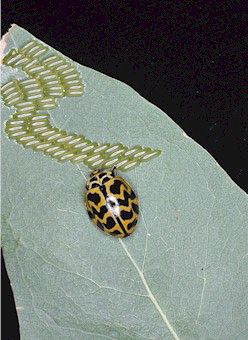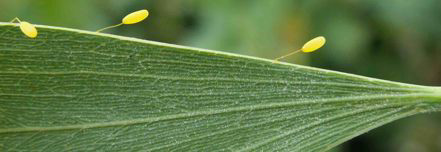PESTS AND DISEASES OF FORESTRY IN NEW ZEALAND
Cleobora mellyi - What is it up to these days?
Scion is the leading provider of forest-related knowledge in New Zealand
Formerly known as the Forest Research Institute, Scion has been a leader in research relating to forest health for over 50 years. The Rotorua-based Crown Research Institute continues to provide science that will protect all forests from damage caused by insect pests, pathogens and weeds. The information presented below arises from these research activities.
From Forest Health News 193, March 2009.
Between 1979 and 1987 Cleobora mellyi, an Australian ladybird (Coccinellidae), was reared and released at several sites in New Zealand to control Paropsis charybdis (Chrysomelidae), an Australian species that was first found in New Zealand in 1916. P. charybdis is a serious defoliator of some Eucalyptus spp. here. C. mellyi established at only one site - Maori Bay in the Marlborough Sounds. It has subsequently been found at other sites in the Sounds. For further details see http://www.nzffa.org.nz/pests/Predators/ Marlborough Sounds 2005.html

C. mellyi eats P. charybdis eggs but to reproduce successfully it also requires additional prey, particularly psyllids (Psyllidae). Prior to 1986 there were only two species of psyllids found on Eucalyptus spp. in New Zealand, Ctenarytaina eucalypti and Blastopsylla occidentalis and only the former in occasional high numbers. It is generally well controlled by an encyrtid parasitoid, Psyllaephagus pilosus. It was thought that this paucity of psyllids was a major factor in C. mellyi failing to establish at most release sites. At the Maori Bay site Eucalyptus spp. were planted in mixture with Acacia spp. and the later supported high populations of psyllids, mainly Acizzia acaciae. C. mellyi is known to feed on these psyllids.
Since 1986 another seven species of Australian psyllids that feed on Eucalyptus spp. have established in New Zealand, Glycaspis granulata (1986), Ctenarytaina spatulata (1990), Cardiaspina fiscella (1996), Cryptoneossa triangula (1996), Eucalyptoloma maideni (1996), Anoeconeossa communis (2002) and Creiis liturata (2002). It was thought that these additional pysllid species might provide sufficient supplementary food to enable Cleobora to successfully reproduce on Eucalyptus spp. In 1996 another Australian paropsine beetle, Dicranosterna semipunctata (Chrysomelidae) was found in New Zealand for the first time. It was feeding on Acacia melanoxylon growing on a golf course in Auckland. A. melanoxylon is the main host of D. semipunctata but it has been recorded from other Acacia spp. and Paraserianthes lophanta.
In the early 2000s concern was mounting about the amount of damage on Acacia melanoxylon caused by Dicranosterna semipunctata and it was about the same time that Cleobora were found feeding on D. semipunctata eggs on A. melanoxylon. This resulted in a Ministry of Agriculture Forestry Sustainable Farming Fund funded project involving the Acacia melanoxylon Interest Group Organisation (AMIGO), the Eucalyptus Action Group (EAG) and Scion. The project involved collecting Cleobora from the field in the Marlborough Sounds and mass rearing them for release. This was done at about 18 locations, mainly in the North Island but also in Southland.
We can now report that Cleobora mellyi is established in Northland and the Bay of Plenty as well as the Marlborough Sounds and further work is planned to determine its distribution throughout the country.

In a somewhat novel twist Zonda Resources Ltd and Plant and Food Research are using Cleobora in trials to control Bactericera cockerelli the potato-tomato psyllid in tomato and capsicum crops. Initial results are promising. This psyllid was first found in New Zealand on a greenhouse tomato crop in Auckland in April 2006 and is now found throughout most of the country, both indoors and outdoors. For further information on this psyllid see www.hortnz.co.nz/communications/pdfs/ psyllidJfactsheet.pdf
Thanks to Terril Marais of Zonda Resources for supplying information on Bactericera cockerelli.
Toni Withers & John Bain
This information is intended for general interest only. It is not intended to be a substitute for specific specialist advice on any matter and should not be relied on for that purpose. Scion will not be liable for any direct, indirect, incidental, special, consequential or exemplary damages, loss of profits, or any other intangible losses that result from using the information provided on this site.
(Scion is the trading name of the New Zealand Forest Research Institute Limited.)

 Farm Forestry New Zealand
Farm Forestry New Zealand

